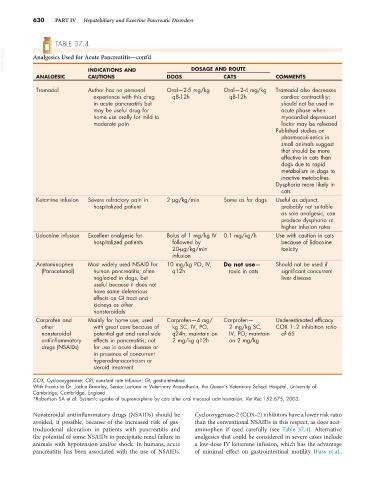Page 658 - Small Animal Internal Medicine, 6th Edition
P. 658
630 PART IV Hepatobiliary and Exocrine Pancreatic Disorders
TABLE 37.4
VetBooks.ir Analgesics Used for Acute Pancreatitis—cont’d DOSAGE AND ROUTE
CAUTIONS
ANALGESIC INDICATIONS AND DOGS CATS COMMENTS
Tramadol Author has no personal Oral—2-5 mg/kg Oral—2-4 mg/kg Tramadol also decreases
experience with this drug q8-12h q8-12h cardiac contractility;
in acute pancreatitis but should not be used in
may be useful drug for acute phase when
home use orally for mild to myocardial depressant
moderate pain factor may be released
Published studies on
pharmacokinetics in
small animals suggest
that should be more
effective in cats than
dogs due to rapid
metabolism in dogs to
inactive metabolites.
Dysphoria more likely in
cats
Ketamine infusion Severe refractory pain in 2 µg/kg/min Same as for dogs Useful as adjunct,
hospitalized patient probably not suitable
as sole analgesic; can
produce dysphoria at
higher infusion rates
Lidocaine infusion Excellent analgesic for Bolus of 1 mg/kg IV 0.1 mg/kg/h Use with caution in cats
hospitalized patients followed by because of lidocaine
20-µg/kg/min toxicity
infusion
Acetaminophen Most widely used NSAID for 10 mg/kg PO, IV, Do not use— Should not be used if
(Paracetamol) human pancreatitis; often q12h toxic in cats significant concurrent
neglected in dogs, but liver disease
useful because it does not
have same deleterious
effects on GI tract and
kidneys as other
nonsteroidals
Carprofen and Mainly for home use; used Carprofen—4 mg/ Carprofen— Underestimated efficacy
other with great care because of kg SC, IV, PO, 2 mg/kg SC, COX 1 : 2 inhibition ratio
nonsteroidal potential gut and renal side q24h; maintain on IV, PO; maintain of 65
antiinflammatory effects in pancreatitis; not 2 mg/kg q12h on 2 mg/kg
drugs (NSAIDs) for use in acute disease or
in presence of concurrent
hyperadrenocorticism or
steroid treatment
COX, Cyclooxygenase; CRI, constant rate infusion; GI, gastrointestinal.
With thanks to Dr. Jackie Brearley, Senior Lecturer in Veterinary Anaesthesia, the Queen’s Veterinary School Hospital, University of
Cambridge, Cambridge, England.
*Robertson SA et al: Systemic uptake of buprenorphine by cats after oral mucosal administration, Vet Rec 152:675, 2003.
Nonsteroidal antiinflammatory drugs (NSAIDs) should be Cyclooxygenase-2 (COX-2) inhibitors have a lower risk ratio
avoided, if possible, because of the increased risk of gas- than the conventional NSAIDs in this respect, as does acet-
troduodenal ulceration in patients with pancreatitis and aminophen if used carefully (see Table 37.4). Alternative
the potential of some NSAIDs to precipitate renal failure in analgesics that could be considered in severe cases include
animals with hypotension and/or shock. In humans, acute a low-dose IV ketamine infusion, which has the advantage
pancreatitis has been associated with the use of NSAIDs. of minimal effect on gastrointestinal motility (Fass et al.,

